The Global Baby Diaper Market size is expected to reach $99.7 billion by 2030, rising at a market growth of 5.2% CAGR during the forecast period. In the year 2022, the market attained a volume of 15,956.5 million units, experiencing a growth of 5.0% (2019-2022).
With increased incomes, parents have more financial capacity to afford premium diaper products. These higher-end options often have advanced features such as better absorption, softer materials, wetness indicators, and additional convenience elements. Therefore, the organic segment will capture 13.1% share in the market by 2030. Higher-income households are more likely to prioritize quality and comfort for their babies. They may be willing to spend more on diapers that offer superior absorption, reduced leakage, and a softer feel to ensure their baby's comfort and minimize the chances of diaper rash or discomfort. Additionally, premium diapers often offer added convenience features, such as wetness indicators or superior absorption, which align with the busy schedules of working parents. These features can justify a higher price point due to the time-saving benefits they provide. Some of the factors impacting the market are rise in birth rates in several nations, urbanizations and changing lifestyles, and increasing cost of raw materials.
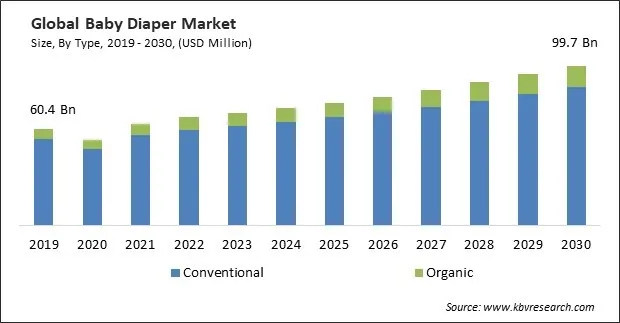
Higher birth rates mean more babies being born. Each baby requires a substantial number of diapers throughout infancy and toddlerhood. Therefore, an increase in the number of births leads to a direct and immediate surge in the demand for diapers. Unlike other consumer products, the demand for diapers is relatively consistent and stable in response to birth rates. Babies require diapers from birth until they are potty trained, typically over several years. This means that as long as birth rates remain elevated, the demand for diapers is sustained over an extended period. Additionally, urbanization often brings about faster-paced, hectic lifestyles. With both parents working, time becomes a precious commodity. Disposable diapers offer convenience, reducing the time and effort needed for changing and cleaning, thus aligning well with the fast-paced urban lifestyle. Disposable diapers are user-friendly, easy to use, and hassle-free. For urban parents juggling various responsibilities, the convenience of disposables becomes essential, as they require less maintenance and are readily available for quick changes, fitting well into busy schedules. These aspects will pose lucrative growth prospects for the market in the coming years.
However, price fluctuations in key raw materials can create significant cost pressures for diaper manufacturers. Increasing the prices of absorbent polymers, pulp, or other essential components directly impacts production expenses, potentially squeezing profit margins. A rise in the costs of raw materials used in diaper manufacturing increases the overall production expenses. As a result, manufacturers may face challenges in maintaining their profit margins unless they increase the prices of their products or implement cost-saving measures elsewhere. These aspects will hinder the growth of the market in the future.
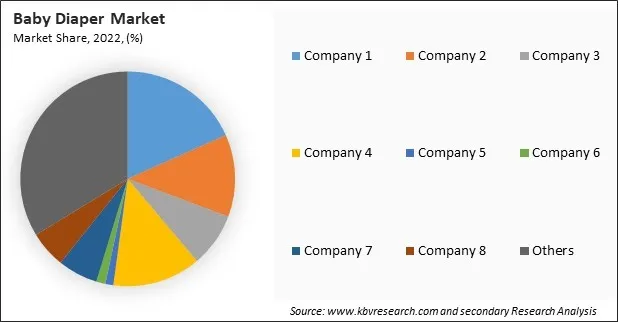
The leading players in the market are competing with diverse innovative offerings to remain competitive in the market. The above illustration shows the percentage of revenue shared by some of the leading companies in the market. The leading players of the market are adopting various strategies in order to cater demand coming from the different industries. The key developmental strategies in the market are Acquisitions, and Partnerships & Collaborations.
On the basis of type, the market is divided into conventional and organic. The conventional segment procured the highest revenue share in the market in 2022. Conventional diapers have seen continuous improvements in terms of absorbency, leak protection, and overall performance. Innovations in materials and design have increased their efficiency, driving continued demand among parents seeking reliable products for their babies. Ongoing technological advancements have resulted in the development of diapers with enhanced features such as wetness indicators, improved elasticity for better fit, and hypoallergenic materials, providing added comfort and convenience.
Based on product, the market is segmented into disposable and non-disposable. The non-disposable segment acquired a significant revenue share in the market in 2022. Non-disposable diapers, such as cloth diapers, are often considered cost-effective in the long run. While the initial investment might be higher, the ability to reuse these diapers for an extended period makes them a more economical choice over time, especially for families with multiple children. Non-disposable diaper options have improved in terms of design, comfort, and functionality. Modern cloth diapers come with features like adjustable sizes, absorbent materials, and user-friendly fastenings, making them more convenient and user-friendly for parents.
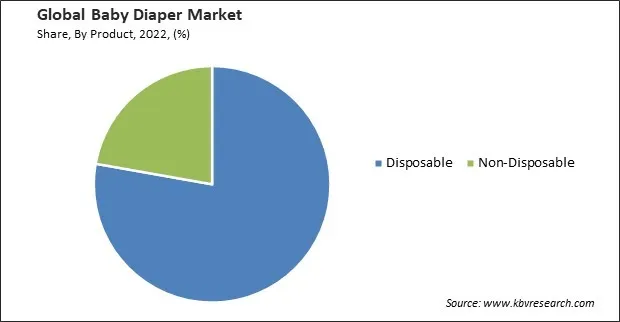
Based on distribution channel, the market is segmented into offline and online. In 2022, the offline segment garnered the largest revenue share in the market. Offline retail outlets provide tangible visibility for various brands, allowing customers to see, touch, and compare products physically. This hands-on experience often influences purchasing decisions. Many consumers, particularly parents, often prefer buying baby diapers from physical stores where they can see the product quality firsthand and engage with knowledgeable staff. This builds trust and confidence in the product, especially for first-time parents seeking advice and recommendations. These aspects will pose lucrative growth prospects for the segment.
| Report Attribute | Details |
|---|---|
| Market size value in 2022 | USD 63.5 Billion |
| Market size forecast in 2030 | USD 99.7 Billion |
| Base Year | 2022 |
| Historical Period | 2019 to 2021 |
| Forecast Period | 2023 to 2030 |
| Revenue Growth Rate | CAGR of 5.2% from 2023 to 2030 |
| Number of Pages | 305 |
| Number of Table | 630 |
| Quantitative Data | Volume in Million Units, Revenue in USD Billion, and CAGR from 2019 to 2030 |
| Report coverage | Market Trends, Revenue Estimation and Forecast, Segmentation Analysis, Regional and Country Breakdown, Market Share Analysis, Porter’s 5 Forces Analysis, Company Profiling, Companies Strategic Developments, SWOT Analysis, Winning Imperatives |
| Segments covered | Type, Product, Distribution Channel, Region |
| Country scope |
|
| Companies Included | The Procter and Gamble Company, Kimberly-Clark Corporation, Hengan International Group Company Limited, Unicharm Corporation (DSG International (Thailand) PLC), Johnson & Johnson, Ontex BV, The Hain Celestial Group, Inc., The Honest Company, Inc., Essity AB, and Kao Corporation |
| Growth Drivers |
|
| Restraints |
|
By region, the market is segmented into North America, Europe, Asia Pacific, and LAMEA. The Asia Pacific segment procured the highest revenue share in the market in 2022. The Asia Pacific region is densely populated, and it has a considerable birth rate, contributing to a large and increasing infant population. This directly impacts the demand for baby diapers, as more infants require these essential products. Economic growth in many countries within the Asia Pacific region has led to an increase in disposable income for families. Urbanization has led to changes in lifestyle, with more parents working and seeking convenience in childcare products. This shift towards a more fast-paced lifestyle has increased the demand for disposable diapers due to their convenience and time-saving features.
Free Valuable Insights: Global Baby Diaper Market size to reach USD 99.7 Billion by 2030
The market research report covers the analysis of key stake holders of the market. Key companies profiled in the report include The Procter and Gamble Company, Kimberly-Clark Corporation, Hengan International Group Company Limited, Unicharm Corporation (DSG International (Thailand) PLC), Johnson & Johnson, Ontex BV, The Hain Celestial Group, Inc., The Honest Company, Inc., Essity AB, and Kao Corporation
By Type (Volume, Million Units, USD Billion, 2019 to 2030)
By Product (Volume, Million Units, USD Billion, 2019 to 2030)
By Distribution Channel (Volume, Million Units, USD Billion, 2019 to 2030)
By Geography (Volume, Million Units, USD Billion, 2019 to 2030)
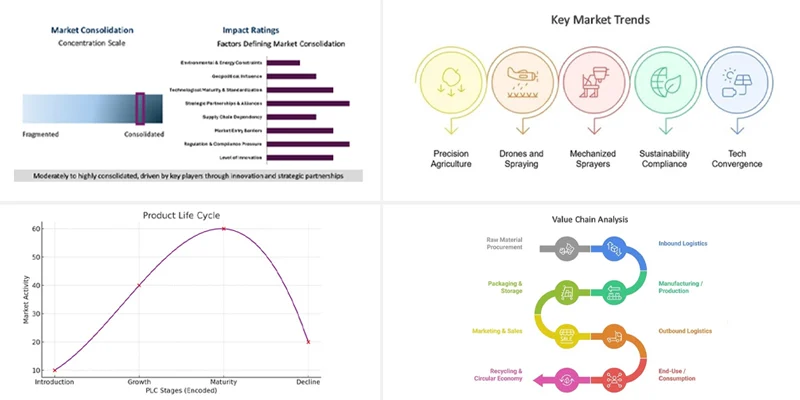
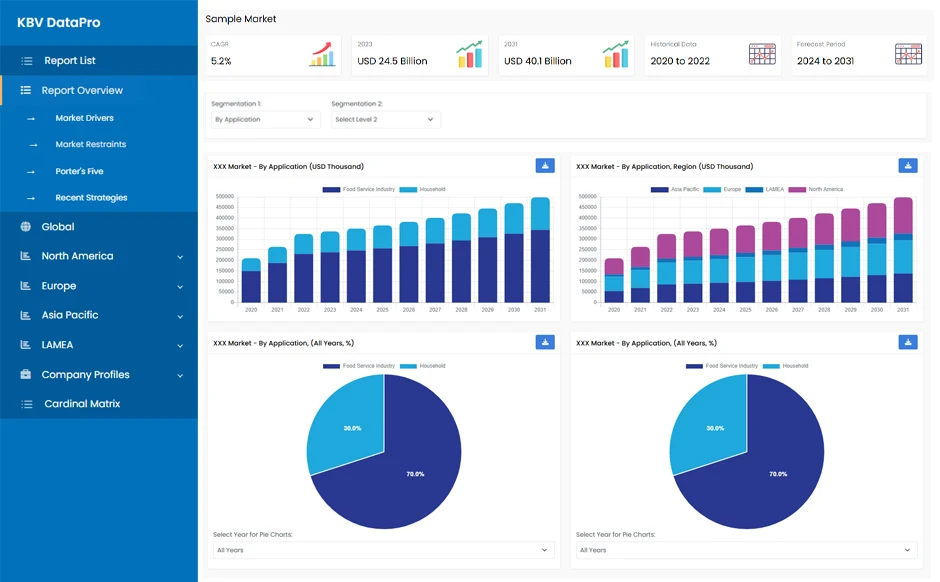
This Market size is expected to reach $99.7 billion by 2030.
Rise in birth rates in several nations are driving the Market in coming years, however, Increasing cost of raw materials restraints the growth of the Market.
The Procter and Gamble Company, Kimberly-Clark Corporation, Hengan International Group Company Limited, Unicharm Corporation (DSG International (Thailand) PLC), Johnson & Johnson, Ontex BV, The Hain Celestial Group, Inc., The Honest Company, Inc., Essity AB, and Kao Corporation
In the year 2022, the market attained a volume of 15,956.5 million units, experiencing a growth of 5.0% (2019-2022).
The Disposable segment is registering maximum revenue in the Market, By Product in 2022; thereby, achieving a market value of $75.6 billion by 2030.
The Asia Pacific region is capturing maximum revenue in the Market, By Region in 2022, and would continue to be a dominant market till 2030; thereby, achieving a market value of $42.4 billion by 2030.
Our team of dedicated experts can provide you with attractive expansion opportunities for your business.

